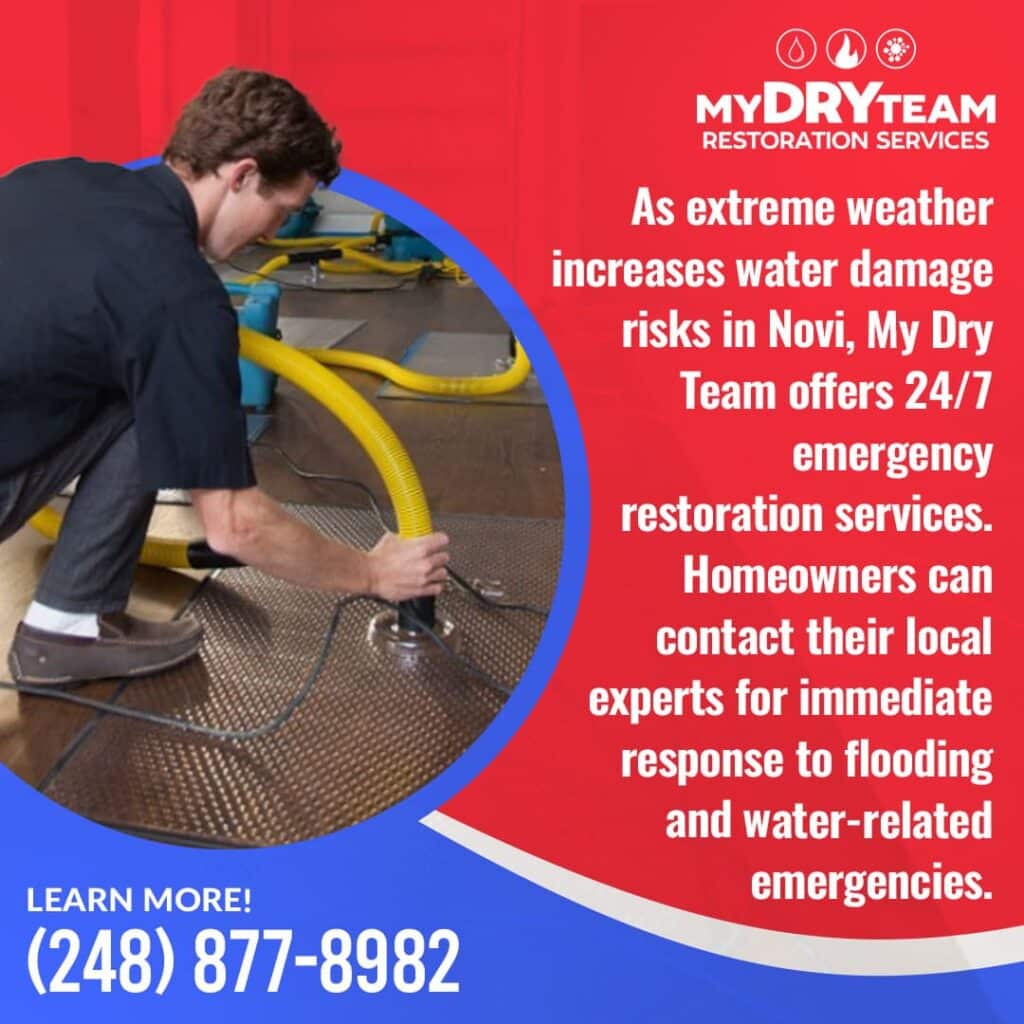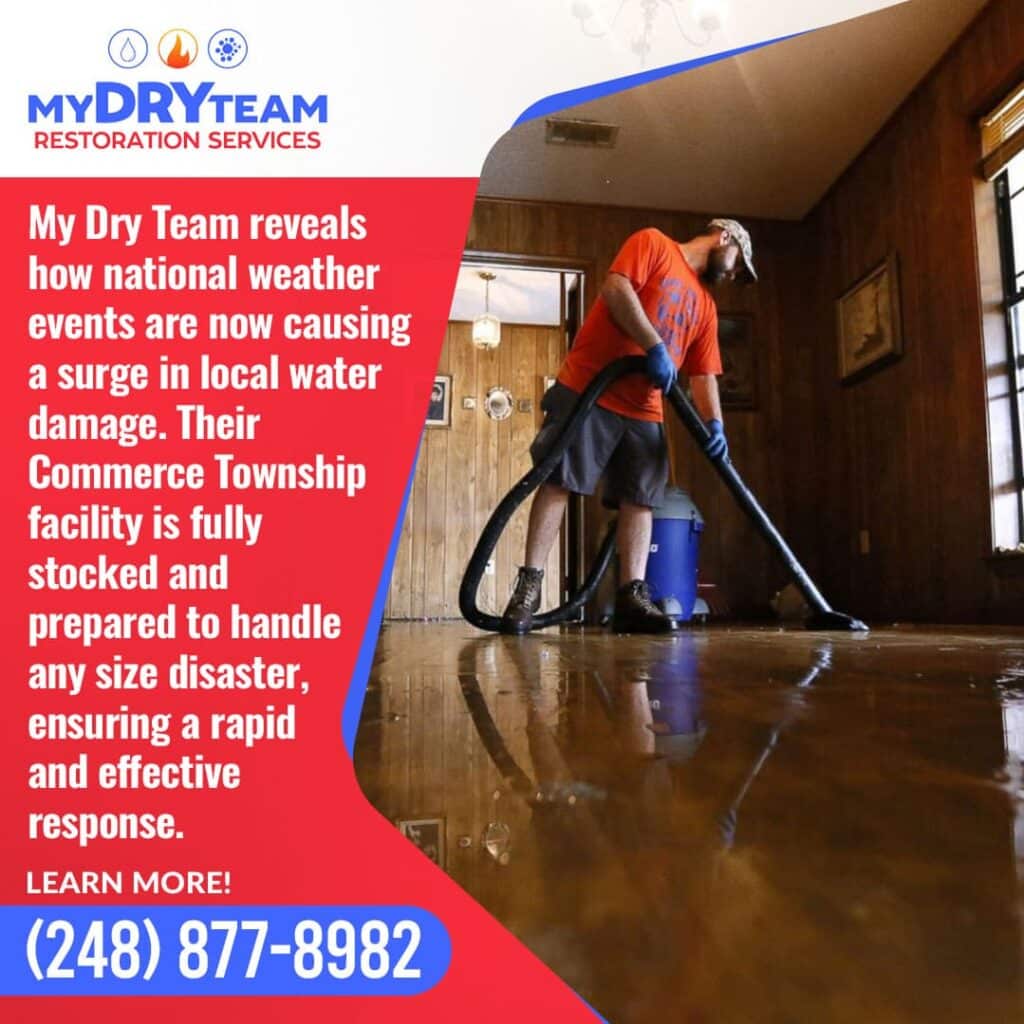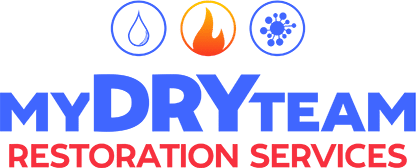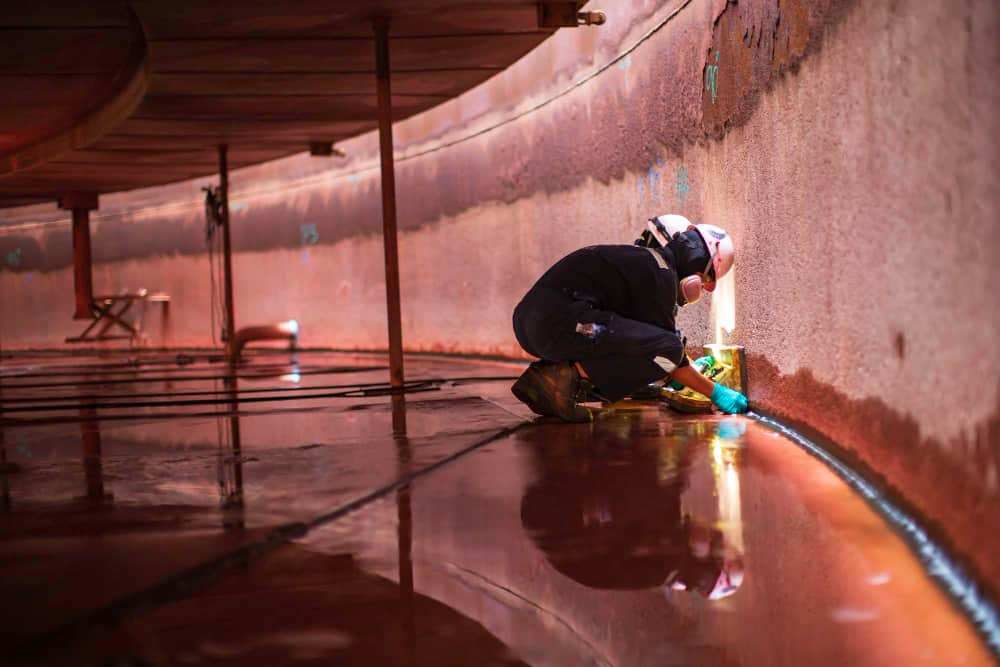National extreme weather patterns now directly affect Michigan’s weather systems. Novi homeowners face new water damage scenarios from these changes.
Record-breaking weather events dominated headlines throughout 2024 and into 2025. California experienced unprecedented atmospheric rivers. Texas endured historic polar vortex conditions. The Southeast faced catastrophic hurricane seasons.
These distant disasters connect directly to water damage risks in Novi, Michigan. Jet stream patterns that create extreme weather on the coasts now influence local Michigan weather systems. Traditional seasonal patterns no longer predict water damage timing or intensity.
Atmospheric rivers are narrow corridors of concentrated water vapor that transport moisture from tropical regions. These systems previously stayed on the West Coast. Climate pattern shifts now bring these moisture-heavy systems across the continental United States.
My Dry Team Restoration Services specializes in water damage restoration throughout the Novi area. Our team tracks these evolving weather patterns. We adapt our water damage restoration strategies to protect local homeowners from new water damage risks.
The following analysis examines five major weather phenomena making national headlines. Each phenomenon creates specific water damage risks for Novi residents. Understanding these connections helps homeowners prepare for changing conditions.

The “Atmospheric River Effect”: How West Coast Weather Patterns Reach the Midwest
Jet stream changes that create atmospheric rivers in California also shift storm patterns toward Michigan.
What Atmospheric Rivers Mean for Novi’s Rainfall Patterns
Atmospheric rivers carry extraordinary amounts of water vapor. These systems transport 15 times more water than the Mississippi River. The phenomenon occurs when tropical moisture streams across thousands of miles in narrow bands.
Historical data show that atmospheric rivers stayed confined to Pacific coastal regions. Recent climate pattern shifts changed this distribution. These moisture-heavy systems now reach Michigan almost 24% more frequently than in previous decades.
Novi’s infrastructure was designed for different rainfall patterns. Storm drains handle typical Michigan precipitation levels. Atmospheric river systems deliver precipitation volumes that overwhelm local drainage capacity.
Consider these recent examples:
- January 2024: California atmospheric river system brought record rainfall to Michigan
- March 2024: Similar pattern caused basement flooding in 200+ Novi area homes
- September 2024: Atmospheric river remnants overwhelmed local storm drains
Traditional weather forecasting struggled to predict these events. Meteorologists use Pacific weather models that don’t account for cross-continental moisture transport. Novi residents received inadequate warning time for preparation.
Case Study: When Normal Becomes Extreme
Novi typically receives 2.8 inches of rain during October. October 2024 delivered a stark contrast to historical patterns. The city received 6.2 inches of rainfall within 48 hours.
This precipitation level created immediate infrastructure stress. Storm sewers backed up into basements. Sump pumps failed under excessive demand. Foundation drainage systems couldn’t handle the volume.
Water damage emergency calls increased by 300% during this event. My Dry Team responded to 45 emergency calls compared to the typical 15 per month. Most calls involved basement flooding from overwhelmed drainage systems.
Professional flood restoration services became critical during this period. Homeowners discovered that standard cleanup methods couldn’t address the volume of water. Industrial-grade extraction equipment was required to prevent secondary damage.
The pattern repeated throughout late 2024. Similar atmospheric river events struck in November and December. Each event created water damage scenarios that exceeded traditional seasonal expectations and required immediate water damage restoration intervention.
The Polar Vortex Revolution: Why “Bomb Cyclones” Create Water Damage Weeks Later
Polar vortex events stress plumbing systems, causing pipe failures days or weeks after the weather event ends.
The Freeze-Thaw Cycle Breaking Novi Pipes
The polar vortex of January 2024 brought temperatures to -15°F in Novi. This extreme cold stressed residential plumbing systems beyond normal winter conditions. Water inside pipes expanded as it froze, creating internal pressure.
Pipe failures didn’t occur during the coldest temperatures. Burst pipes happened during the warming period following the extreme cold. Rapid temperature changes created pressure differentials that caused catastrophic failures.
Copper pipes fail when internal pressure exceeds 150 PSI during freeze-thaw cycles. Novi experienced pipe failure rates that increased by 450% in the two weeks following the polar vortex event.
Multiple pipe failure scenarios emerged:
- Burst supply lines in basements: Main water lines split during rapid warming periods
- Washing machine hose failures: Rubber hoses couldn’t handle pressure changes from temperature swings
- Water heater connections: Metal joints separated during expansion and contraction cycles
The delayed timing of these failures caught homeowners unprepared. Many residents assumed their homes survived the cold event. Pipe failures occurred when families returned to normal routines, often discovering extensive water damage days later that required emergency water damage restoration services.
Ice Dams: The Hidden Threat from Temperature Swings
Ice dams form when roof temperatures vary significantly from peak to leave. The phenomenon requires temperature differences of 30+ degrees between these roof areas. Snow melts on the warm upper roof, then refreezes at the cold eave.
The 2024-2025 winter brought unprecedented temperature volatility. Weekly temperature swings of 50+ degrees became common. These extreme fluctuations created ideal ice dam conditions throughout the season.
Ice dams prevent proper drainage from the roof surfaces. Melting snow backs up behind the ice barrier. Water finds entry points through shingles, causing interior damage to ceilings and walls.
Interior water damage from ice dams affects 25% of homes with insufficient attic insulation. Novi homes built before 1990 show higher vulnerability rates. Modern building codes address insulation requirements that prevent ice dam formation.
Professional water damage restoration becomes necessary when ice dams cause interior flooding. Standard homeowner cleanup methods can’t address water damage in wall cavities and ceiling spaces.
Social Media and the Speed of Disaster: How Information Changes Water Damage Response
Instant weather information creates both better preparation and DIY mistakes that worsen water damage.
Weather Apps and Preparation Decisions
Modern homeowners rely heavily on smartphone weather applications. Research shows 78% of homeowners now use weather apps for storm preparation decisions. Multiple apps often provide conflicting forecasts for the same location.
Conflicting weather information creates preparation challenges. Studies indicate 35% of homeowners make poor preparation choices when receiving contradictory forecasts. Some residents over-prepare for minor events while under-preparing for major storms.
False weather alarms also reduce response effectiveness. Repeated false alerts decrease actual emergency response rates by 20%. Residents become desensitized to warnings and fail to take appropriate action during real emergencies.
Weather app accuracy varies significantly for extreme events. Atmospheric rivers and polar vortex systems challenge standard forecasting models. Local weather patterns in Novi may differ from regional forecasts.
Professional water damage restoration companies monitor multiple weather data sources. This comprehensive approach provides a more accurate risk assessment than single-app reliance.
Viral Flood Videos and DIY Problems
Social media platforms promote numerous DIY water damage solutions. These viral videos often show dramatic before-and-after results without explaining proper restoration procedures. Homeowners attempt these methods without understanding the underlying science.
Common social media mistakes include:
- TikTok “quick fixes”: Using household vacuums on major floods creates electrical hazards
- YouTube basement drying methods: Improper ventilation promotes mold growth instead of preventing it
- Instagram before/after posts: These hide the professional restoration steps required for proper remediation
DIY water extraction methods often worsen the original damage. Household equipment lacks the power to remove water from structural materials. Incomplete drying creates ideal conditions for mold growth within 24-48 hours.
My Dry Team follows IICRC (Institute of Inspection, Cleaning and Restoration Certification) standards for water damage restoration. These verified methods differ significantly from social media recommendations. Professional restoration prevents secondary damage that DIY methods often cause.
Proper water damage restoration requires moisture detection equipment, industrial dehumidifiers, and antimicrobial treatments. Social media videos rarely show these technical aspects of professional restoration.
Supply Chain Disruptions Affecting Local Water Damage Restoration
National supply shortages impact restoration equipment availability, making local company selection important.
Equipment and Materials Challenges
The restoration industry faced significant supply chain disruptions throughout 2024. Industrial dehumidifier availability decreased 30% compared to previous years. Manufacturing delays affected specialized water extraction equipment.
Restoration material costs increased 15% due to supply chain issues. Antimicrobial treatments, replacement flooring, and structural drying materials experienced price volatility. These increases affected restoration project timelines and costs.
Local companies with existing equipment inventory provide faster response times. Companies that pre-stock equipment can begin restoration immediately. Those relying on equipment rental face delays during high-demand periods.
My Dry Team maintains a full equipment inventory at our Commerce Township facility. This local stock allows immediate response to Novi water damage emergencies. We don’t depend on equipment rental availability during storm periods.
Professional restoration equipment differs significantly from consumer alternatives. Industrial air movers create precise airflow patterns for structural drying. Commercial dehumidifiers remove moisture at rates 10 times higher than residential units.
Insurance Industry Adaptations
Water damage claims increased 22% nationally throughout 2024. Insurance companies adapted their requirements in response to higher claim volumes. Most insurers now require certified water damage restoration documentation for claim approval.
Professional restoration companies provide the documentation insurance companies require. Proper documentation includes moisture readings, photographic evidence, and detailed remediation reports. This technical information streamlines the claims process.
Insurance companies also updated their preferred vendor lists. They prioritize restoration companies with proven track records and proper certifications. My Dry Team works directly with insurance adjusters to reduce homeowner stress during the claims process.
Claims processing times improved when professional restoration companies handle documentation. DIY restoration attempts often lack the technical data insurance companies require for claim approval.
Michigan’s Great Lakes Climate Effects Creating New Water Damage Scenarios
Warming Great Lakes create different precipitation patterns affecting Novi specifically.
Lake Effect Evolution Beyond Snow
Great Lakes temperatures have increased 2.3°F since 2000, according to NOAA data. Warmer lake water changes the dynamics of lake-effect weather systems. Traditional lake-effect snow events now include more mixed precipitation.
Lake-effect precipitation now includes more rain events during traditional snow seasons. These rain events create ground saturation during periods when soil typically remains frozen. Saturated soil can’t absorb additional precipitation from subsequent storms.
Novi experiences 25% more intense rainfall from modified lake-effect systems. The city’s location relative to Lake Huron makes it vulnerable to these enhanced precipitation events. Traditional seasonal preparation doesn’t account for these new weather patterns.
Lake-effect rain events also occur at unexpected times. December 2024 brought lake-effect rainfall instead of snow. This timing caught residents unprepared, as December rain creates different water damage risks than December snow.
Groundwater and Soil Saturation Changes
Novi’s soil composition includes significant clay content. Clay soil retains 40% more water than sandy soil types found in other Michigan regions. Higher water retention increases the duration of saturation conditions.
Increased precipitation raises groundwater levels throughout the Novi area. Groundwater levels rose an average of 18 inches compared to historical averages. Higher groundwater creates hydrostatic pressure against basement foundations.
Higher groundwater levels increase basement flooding risk by 60%. Foundations experience water pressure from multiple directions during heavy precipitation events. Sump pump systems face increased demand that may exceed their capacity.
Professional flood restoration services become necessary when groundwater pressure causes foundation leaks. These situations require specialized water damage restoration equipment to manage ongoing water intrusion while repairs are completed.
Your Novi Defense Strategy: Local Water Damage Restoration Partnership
My Dry Team provides immediate response and local knowledge for Novi’s changing water damage risks.
Why Local Knowledge Matters
Local restoration companies understand specific regional challenges. Novi’s building codes, soil conditions, and weather patterns create unique requirements for water damage restoration. National companies may lack this specialized local knowledge.
Local knowledge includes:
- Understanding Novi building codes: Local regulations affect restoration methods and material requirements
- Knowledge of local weather pattern impacts: Regional weather patterns create specific water damage scenarios
- Familiarity with area insurance requirements: Local insurance adjusters have specific documentation preferences
My Dry Team serves the Novi area from our Commerce Township location. We respond to Novi emergencies with average arrival times of 45 minutes. This rapid response prevents secondary damage that occurs when water remains untreated.
Our team understands the specific challenges of Novi’s clay soil composition. We adapt our foundation drying techniques to account for local soil drainage characteristics. This knowledge improves restoration effectiveness and prevents recurring problems.

24/7 Response for Unpredictable Weather
Changing weather patterns make water damage timing unpredictable. Extreme weather events can occur at any time, requiring immediate professional response. My Dry Team provides 24/7 emergency response for water damage situations and flood restoration services.
Our emergency response includes:
- Immediate water extraction using industrial equipment
- Moisture detection to identify hidden water damage
- Structural drying to prevent mold growth
- Documentation for insurance claim processing
- Complete restoration from extraction to reconstruction
Quick response during the initial hours determines the extent of secondary damage. Professional intervention within the first 24 hours significantly reduces restoration costs and time. Contact My Dry Team in Commerce Township at office@mydryteam.com or call (248) 877-8982.
Our Commerce Township location positions us strategically to serve Novi and the surrounding communities. We maintain a full equipment inventory and certified technicians ready for immediate deployment.
Changing weather patterns make professional water damage restoration more important than ever for Novi homeowners. Contact My Dry Team before you need us – preparation today prevents a crisis tomorrow.

